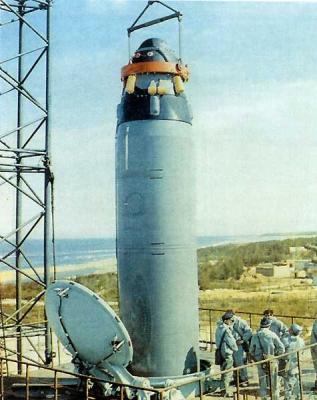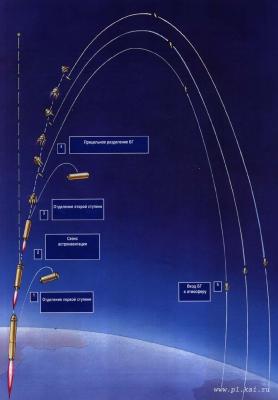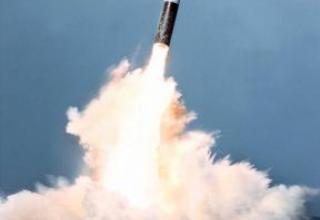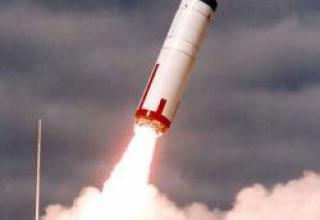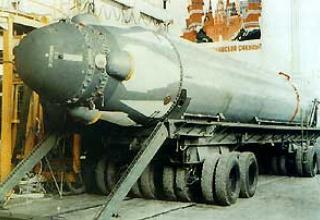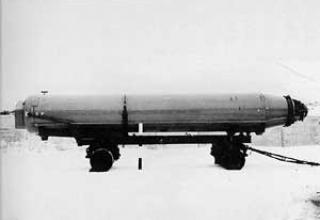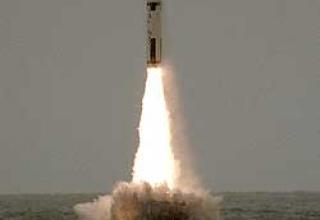In the early 70's, the Design Bureau of Academician V. Makeev in response to the deployment of marine ballistic missiles with separating warheads (SHM) in the U.S. began research and development of two marine missiles with intercontinental range: liquid-propellant SSM-50 and solid-propellant SSM-52. The RSM-50 (R-29R, 3M40) missile, its control system and missile system used circuit, structural and technological solutions that had been tested and verified on R-29 (RSM-40) missiles.
The D-9R complex with R-29R missile was created in a very short period of time, less than four years, which allowed the Navy to start deployment of missiles with intercontinental range and separable head units two or three years earlier than abroad. Later on, the complex with the RSM-50 missile was repeatedly upgraded, as a result of which the combat units were replaced by more advanced ones and the conditions of their combat application were expanded. For the first time, the new missile system ensured the formation of any number of salvo missiles, which was a very important operational and tactical circumstance.
The RSM-50 missile was designed to carry 667BDR SSBNs (according to NATO classification - "Delta-III", under the START-1 treaty - "Kalmar"). The K-441 leadboat went into service in December 1976. In the period from 1976 to 1984 the Northern and Pacific Fleets received 14 submarines of this type with D-9R complex. Nine of them are in the Pacific Fleet, and one of the five Squids of the Northern Fleet was decommissioned in 1994.
Joint R-29R flight tests were conducted from November 1976 to October 1978 in the White and Barents Seas on the K-441 lead boat. A total of 22 missiles were launched, four of them in monobloc, six in triple-block and 12 in seven-block equipment. Positive test results made it possible to adopt a missile with RSH IN as part of the D-9R missile system in 1979.
Three modifications were created on the basis of R-29: R-29R (three-unit), R-29RL (monoblock) and R-29RK (seven-block). Subsequently, the seven-block version was abandoned, mainly due to the imperfection of the combat unit layout system. At present, the missile is in service with the Navy in the optimal for it three-unit configuration.
On the basis of the rocket R-29R created a carrier rocket "Wave".
In the west, the complex was designated SS-N-18 "Stingray".
Composition:
The missile is placed on the nuclear submarines of the project 667BDR with a set of 16 missiles. New technical solutions implemented in the missile:
- the creation of a splitting head unit with individual pointing of combat units at targets;
- the possibility of equipping missiles with different sets of head units;
- application of full astro-correction system and significant increase of firing accuracy;
- creation of high-speed small-size combat units with low dispersion in the atmospheric section of the trajectory.
Rockets can be launched from the submarine's submarine and surface positions.
Two-stage rocket R-29R is made on the "condensed" scheme with "recessed" in the tanks of the propulsion systems. The hulls of the first and second stages consist of waffle structure tank shells made of aluminum-magnesium alloy, two-layer intermediate and single-layer rear and front bottoms. As the power plant of the first stage is used two-block engine, consisting of a fixed main unit and two, placed in cardan hangers, chambers steering unit. The second stage is a single-chamber engine placed in a cardan suspension. Control forces through the channels of pitch and yaw are provided by the engine rocking in the appropriate plane, and through the roll channel - the redistribution of exhaust gases of the turbo pump unit through the control nozzles of the roll.
The rocket steps are separated by the energy of the first stage supercharging gases, the rigid bonds between the steps are removed by the elongated detonation charge. The engines of both stages operate on asymmetric dimethylhydrazine (NDMH) and nitrogen tetraxide (AT). The upper bottom of the fuel tank of the second stage is made in the form of a cone, which houses the combat stage. Fuel tanks are filled at the manufacturing plant, after which the missile is amputated. The missiles can be launched from either an underwater or surface position.
The autonomous inertial control system with astro-correcting flight path apparatus is assembled in the nose of the rocket in an airtight instrument compartment with an astrodome dropped in flight. The application of the full astro-correction system on the missile, which takes into account and compensates for the errors of the submarine's navigation complex both in determining the course and the place of the firing submarine, has provided a significant increase in accuracy of firing. At the first stage of the missile's flight to the target is separated first stage, then there is a session of astronautics, then there is a separation of the second stage, sighting separation of combat units and their entry into the atmosphere.
The instrument cluster is structurally divided into two compartments by an airtight bottom. The first compartment contains a three-axis gyrostabilizer with an astrological device. The control system equipment is mounted on the frame without individual damping of the equipment elements, and the frame is attached to the taphole of the instrument compartment on shock absorbers. This method of mounting the devices allowed increasing the density of their arrangement in the instrument compartment.
The composition of the combat stage includes a liquid propulsion system, a compartment of combat load with combat units and the instrument compartment, which houses the equipment of the control system, providing individual pointing of the units at different targets. To overcome the opponent's missile defence system, the battle stage can be equipped with decoys. The missile's combat compartment can accommodate three nuclear warheads of 200 kt each or seven warheads of 100 kt each, capable of reliably engaging ground targets at ranges up to 6,500 km. One missile carrier is capable of striking 112 targets simultaneously.
The engine compartment of the combat stage includes a four-chamber liquid-propellant engine, fuel tanks, hull and provides guidance for each block to an individual target located within a significant radius. On the outer side of the hull there are combustion chambers and engine nozzles in the stabilization planes, and on the inner side there are fuel tanks made in the form of torus parts. The engine automation and steering elements are assembled in the central part of the compartment. The engine is made according to the open scheme with the turbo-pump system of fuel supply. Control through the channels of pitching and yaw is provided by redistribution of traction of chamber pairs lying in the corresponding stabilization planes.
The combat compartment contains combat blocks, frame, cable network, fixing device and compartments of combat blocks; it is in the volume formed by the concave upper bottom of the second stage fuel tank. Battle units are fixed to the frame and are separated in flight on command from the control system. The instrument compartment with the control system is interchangeable. Replacement of combat units and instrument cluster is performed if necessary and without unloading the missile from the mine.
Characteristics:
| Start mass, t | 35.3 |
| Maximum mass to be thrown, kg | 1650 |
| Maximum firing range, km | 6500 (8000 for P-29RL) |
| Firing accuracy at maximum range (CVO), m | 900 |
| Number of steps | 2 |
| Length, m | 14.1 |
| The diameter of the rocket, m | 1.8 |
Testing:
On October 1, 1999, an underwater missile carrier of the Northern Fleet of Project 667 BDR under the command of Captain 2 rank Tagir Kayayev from the Barents Sea launched a RSM-50 missile. The purpose of the launch was to study the possibility of extending the service life of this type of missile. According to the Navy's press service, the RSM-50 missile was detonated at its design altitude, but according to experts, the missile's failure was caused by technical problems. From the water area of the Sea of Okhotsk, the same type of missile carrier of the Pacific Fleet (PF) under the command of Captain 1 rank Vladimir Bobkov launched a rocket RSM-50, the head of which at the estimated time hit the target at the range Kanin Nose. On October 2, the rocket carrier Petropavlovsk-Kamchatsky of the same project 667 BDR under the command of Captain 2 rank Nikolai Yevmenov launched RSM-50 missile, the head part of which also successfully reached the range Kanin Nose. According to the Navy Commander-in-Chief's assessment, "the accuracy of target engagement was 2 times higher than the standards set for "excellent" . Such a massive ballistic missile test is an unprecedented event in the history of the Russian strategic nuclear forces.
Sources:
- www.flot.com
- Баллистическая ракета Р-29 комплекса Д-9 /Подводный флот СССР и России
- В.П. Кузин, В.И.Никольский Военно-Морской Флот СССР 1945-1991. СПб, "Историческое Морское Общество". 1996
- А.Б. Широкорад Оружие отечественного флота 1945-2000. Минск,Москва, Харвест АСТ, 2001
- Ильин В.Е., А.И. Колесников Подводные лодки России: иллюстрированный справочник. Тверь, Издательство Астрель, 2001
